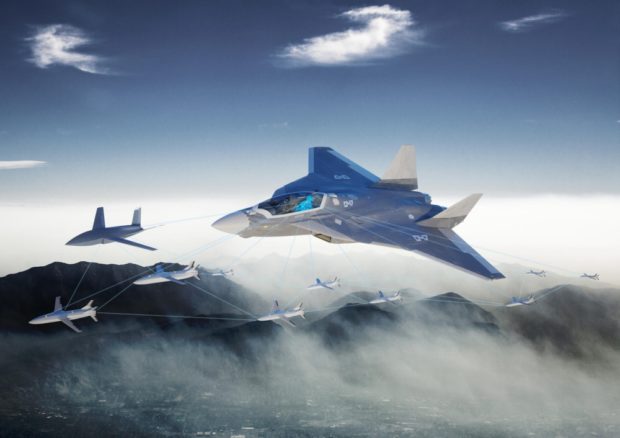The Finnish Defence forces continues to conduct research on the teaming of manned-unmanned aerial vehicles as part of the joint MUM-T project carried out in cooperation with the German defence administration.
Industry from both countries participates in the project. Finland’s part of the research focuses on cooperation between man and machine. The approach is independent of what specific platforms or systems are used.
Tests and flight demonstrations related to the MUM-T research were organised in Rovajärvi and Kemijärvi 12-17 June 2022. The tests directed by the Finnish Defence Forces will be organised in cooperation with the German Armed Forces. Continuing a series of tests from August 2021, the event paves the way for a more extensive flight demonstration to be held in Rovajärvi on 15-19 August, 2022.
The research cooperation strengthens the Defence Forces’ understanding of the development of unmanned aviation, which enables experimenting and evaluating the teaming of unmanned and manned aerial vehicles in the local operational environment. Participation of Finnish industry reinforces national know-how, also contributing to Defence Forces’ other R&D activities.
The cooperation of manned and unmanned systems may also serve to e.g. improve situational awareness, mitigate threats to friendly troops, reduce misjudgements due to fatigue and stress, and improve military capability in situations where human reaction time is not fast enough.
The advancement of weapon technology, the changing character of war and the long development times of defence solutions require the Defence Forces to proactively adopt also technologies projected to be operational in the battlefield only decades later. It is estimated that human-commanded aerial vehicle units will be able to support air force operations starting from the 2030s.
Participating in the MUM-T project is a part of the long-span work conducted by the Defence Forces to improve its know-how in technologies related to unmanned systems, counter measures and data transmission. This work has been pursued with partner countries as well: for example, in the Bold Quest exercise in the spring of 2019 in Sodankylä, which aimed at enhancing and testing the technical compatibility of various intelligence and fire support systems.
As a pioneer in the realm of Manned-Unmanned Teaming (MUM-T), Airbus has developed an ambitious technological roadmap to make this innovative concept – which boosts the effectiveness of piloted and pilotless aircraft alike – a reality. The company demonstrated leading technological and industrial capabilities in 2021 and 2022, including key flight tests.
Fully implementing Manned-Unmanned Teaming – which will play an instrumental role in such initiatives as the Future Combat Air System (FCAS) and Multi-Domain Combat Cloud – requires a high level of automation. However, the involvement of human operators will ensure that meaningful control always will be retained.
Leveraging Airbus’ expertise
The involvement of Airbus with Manned-Unmanned Teaming began in 2018, when the first flight test campaign took place to validate initial capabilities. Since then, the development has seen increasing levels of maturity – with Airbus and its partner teams focusing on several key areas.
Synchronized and efficient use of manned and unmanned vehicles necessitates coordination and optimisation, with requirements that may vary from one mission to the next. To address this, Airbus is developing artificial intelligence-based teaming concepts and algorithms, including swarming behaviours and distributed teaming intelligence shared among the platforms.
This novel approach is reflected in the payloads, which can be integrated on the unmanned aircraft, as well as in the way they are used. For example, a distributed electronic warfare sensor was shown to be capable of precisely and quickly locating a threat and sharing its location across the network.
To achieve such capabilities, the unmanned assets must be able to communicate with the manned resources – and among each other in an agile and robust way, which is why an advanced data link is one pillar of the development.
Additionally, Airbus is preparing airframe solutions for future unmanned systems, building on experience in both unmanned aerial vehicles and combat aircraft. As the development progresses, these solutions will materialise as the FCAS Remote Carriers – unmanned aircraft designed to cooperate with fighters. To achieve the full potential, MUM-T technologies will also need to be relevant for already-existing unmanned aerial systems and for those developed in the future.
Continuing development
Building upon lessons learned from the previous MUM-T-related milestones, Airbus marked a major achievement with a live demonstration that linked company-built Do-DT25 target drones acting as surrogate Remote Carriers with an in-flight German Air Force Eurofighter aircraft. This occurred during the Timber Express 2021 multinational exercise organised by the German Armed Forces.
During the trial, the Eurofighter was able to assign tasks to two Airbus Do-DT25 Remote Carriers in real time. These unmanned platforms demonstrated the ability to perform several tasks, including aerial reconnaissance and electronic warfare. Upon receiving the tasks, the Remote Carriers autonomously planned their flight routes, adhering to prescribed airspace restrictions and circumnavigating known threats.
In 2022, MUM-T-related flight tests were performed outside of Germany for the first time. A test campaign organized in the Finnish areas of Rovaniemi and Kemijärvi – and directed by the Finnish Defence Forces (FDF) – marked the official start of cooperation with the German Armed Forces on this key capability.
In parallel, the capabilities of manned platforms are increasing to accommodate the future potential of Manned-Unmanned Teaming. Airbus’ multi-role A400M airlifter is envisioned as a launcher of FCAS Remote Carriers, with the first flight test already performed to confirm this capability.
Source: Press Releases

